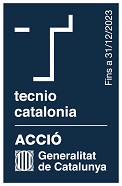IRI Mobile Robotics Laboratory
The Mobile Robotics Laboratory of the Industrial Robotics and Informatics Institute (IRI) is an experimental area mainly dedicated to practical research with mobile robot devices. The lab includes two service robots for urban robotics research based on Segway platforms, a dual mobile manipulator arm custom-built by the company PAL Robotics, a 4-wheel mobile robot for uneven outdoor terrain, a fully automated electric vehicle , 3 Pioneer robots, three autonomous aerial robots (from 500gr to 5Kg payload) and a large number of smaller robots, sensors and cameras. The laboratory is also equipped with an aerial test area (14x7m2) which includes an Optitrack positioning system of 20 IR cameras.

TERRINET: The European robotics research infrastructure network
The European Robotics Research Infrastructures Network (TERRINet) project aims to build an international network with standardized services and complementary capabilities where relevant researchers from academia and industry around the world have access and can explore new ideas and establish personal projects and sets; connect with and be inspired by leading and creative scientists, technologists, experts and industry representatives; share information and gain knowledge to enhance their scientific research and technological innovation potential. TERRINet's plan is to fulfill its vision by providing not only an organized and well-orchestrated set of facilities, but also databases, tools and methodologies that will remain operational after the project is completed, in order to provide a long-term service term in robotics. science and industry in Europe and around the world.
ColRobTransp: Robot-human collaboration for the transport of products in urban areas
The main objective of this project was to advance the design of new mobile robots capable of transporting products in the last mile of urban areas, overcoming complex navigation and product delivery situations with the help of humans. Not only is navigation in busy urban areas complex, but how robots overcome complex street situations, for example, semi-stained streets due to street repair or poorly parked vehicles that do not allow reaching the delivery location, is also important.
EB-SLAM: Event-based simultaneous localization and mapping
This project developed a high-speed, dynamic range mapping and localization device that fuses inertial measurements with those of a dynamic vision system, better known as an event-based camera. This device could be used to estimate the movement of an autonomous vehicle or UAV, in environments without GPS readings, subjected to high dynamics and under conditions of low illumination or severe illumination changes. The problem is multidisciplinary, requiring expertise in computer vision, inertial systems and stochastic estimation. The accuracy and performance of our system will be validated with trajectories recorded with an absolute positioning system (Optitrak). We will build prototypes for three specific applications: humanoid locomotion perception, high-speed autonomous UAV maneuvering, and long-range car estimation. All three applications are subject to sudden lighting changes and/or high-speed movements, conditions for which event cameras are a suitable sensor choice.
Equipment
- Barcelona Robot Lab (10,000 m² pedestrian area to deploy robots in a real and controlled urban setting)
- Robot IVO
- Robots Tibi and Dabo
- Optitrack indoor testbed
- Robot Teo




Share: